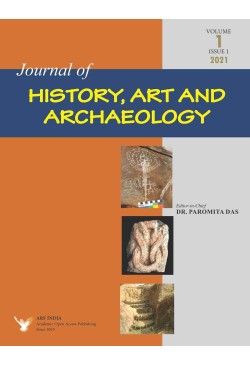
Journal of History, Art and Archaeology
Frequency :Bi-Annual
ISSN :2582-9637
Peer Reviewed Journal
STUDY OF FEMALE FIGURES IN INDIAN ROCK ART WITH SPECIAL REFERENCE TO RAISEN DISTRICT, MADHYA PRADESH, INDIA: IDENTITY, STYLISTIC AND CHRONOLOGICAL ASPECTS
Saleem, S. (2023). Study of Female Figures in Indian Rock Art with Special Reference to Raisen District, Madhya Pradesh, India: Identity, Stylistic and Chronological Aspects. Journal of History, Art and Archaeology, 3: 2, pp. 107-117. https://doi.org/10.47509/JHAA.2023.v03i02.01
THE RIDDLE OF HOYSALA ARTIST BAICHOJA OF NANDI
Kulkarni, R. (2023). The Riddle of Hoysala Artist Baichoja of Nandi. Journal of History, Art and Archaeology, 3: 2, pp. 119-125. https://doi.org/10.47509/JHAA.2023.v03i02.02
ABRIDGED PASTS OF SONEPUR MELA - A SAGA OF PILGRIMAGE AND POWER POLITICS
Isha, A. (2023). Abridged Pasts of Sonepur Mela – A Saga of Pilgrimage and Power Politics. Journal of History, Art and Archaeology, 3: 2, pp. 127-135. https://doi.org/10.47509/JHAA.2023.v03i02.03
TEMPLE GRANTS OF THE RAYAS OF VIJAYANAGARA IN MEDIEVAL ANDHRA DESA
Narasimhulu, K. (2023). Temple Grants of the Rayas of Vijayanagara in Medieval Andhra Desa. Journal of History, Art and Archaeology, 3: 2, pp. 137-142. https://doi.org/10.47509/JHAA.2023.v03i02.04
FRESH LIGHT ON THE MYTHOLOGY AND ICONOGRAPHY OF BHRIN?GI
Kumari, M.K. (2023). Fresh Light on the Mythology and Iconography of Bhringi. Journal of History, Art and Archaeology, 3: 2, pp. 143-157. https://doi.org/10.47509/JHAA.2023.v03i02.05
CONTRASTING ASPECTS OF WOMEN IN THE SCULPTURAL ART OF KUL?TA, HIMACHAL PRADESH
Kumari, S. (2023). Contrasting Aspects of Women in the Sculptural Art of Kuluta, Himachal Pradesh. Journal of History, Art and Archaeology, 3: 2, pp. 159-166. https://doi.org/10.47509/JHAA.2023.v03i02.06